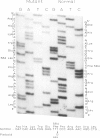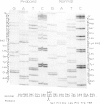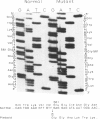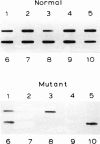Abstract
Piebaldism is an autosomal dominant disorder of melanocyte development and is characterized by congenital white patches of skin and hair from which melanocytes are completely absent. A similar disorder of the mouse, "dominant white spotting" (W), results from mutations of the c-kit proto-oncogene, which encodes the cellular tyrosine kinase receptor for the mast/stem cell growth factor. We have identified c-kit gene mutations in three patients with piebaldism. A missense substitution (Phe----Leu) at codon 584, within the tyrosine kinase domain, is associated with a severe piebald phenotype, whereas two different frameshifts, within codons 561 and 642, are both associated with a variable and relatively mild piebald phenotype. This is consistent with a possible "dominant negative" effect of missense c-kit polypeptides on the function of the dimeric receptor.
Full text
PDF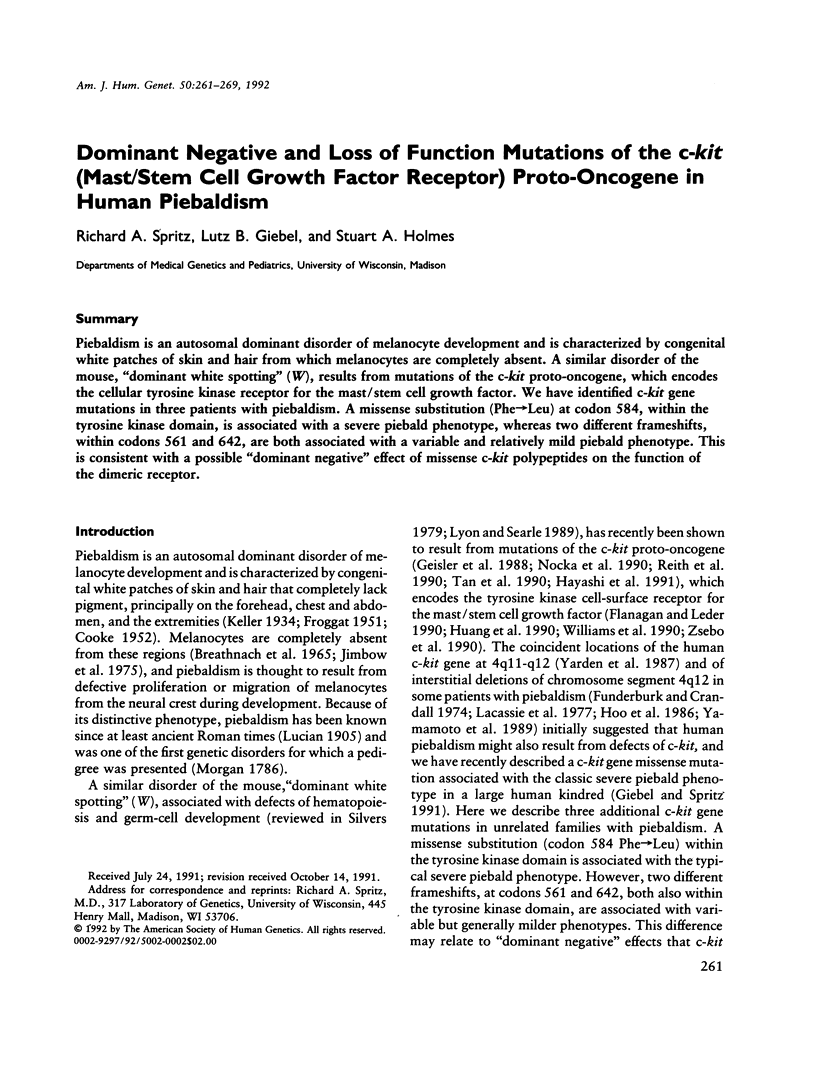
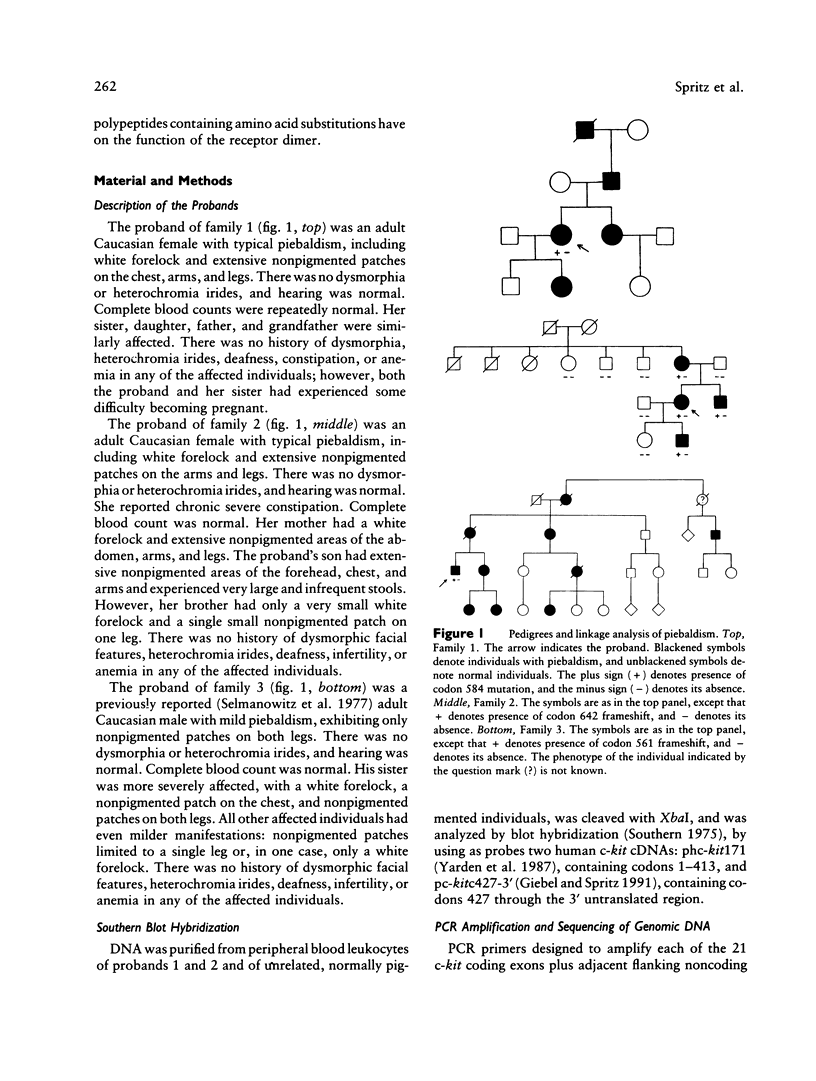
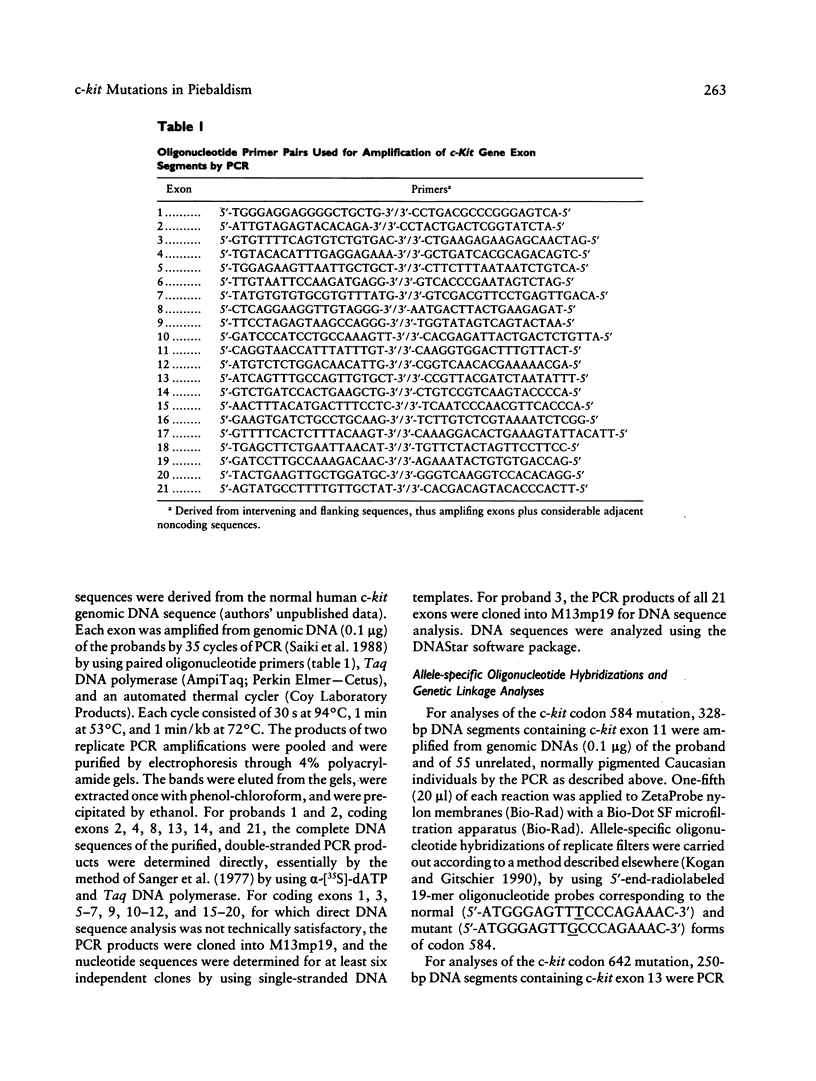
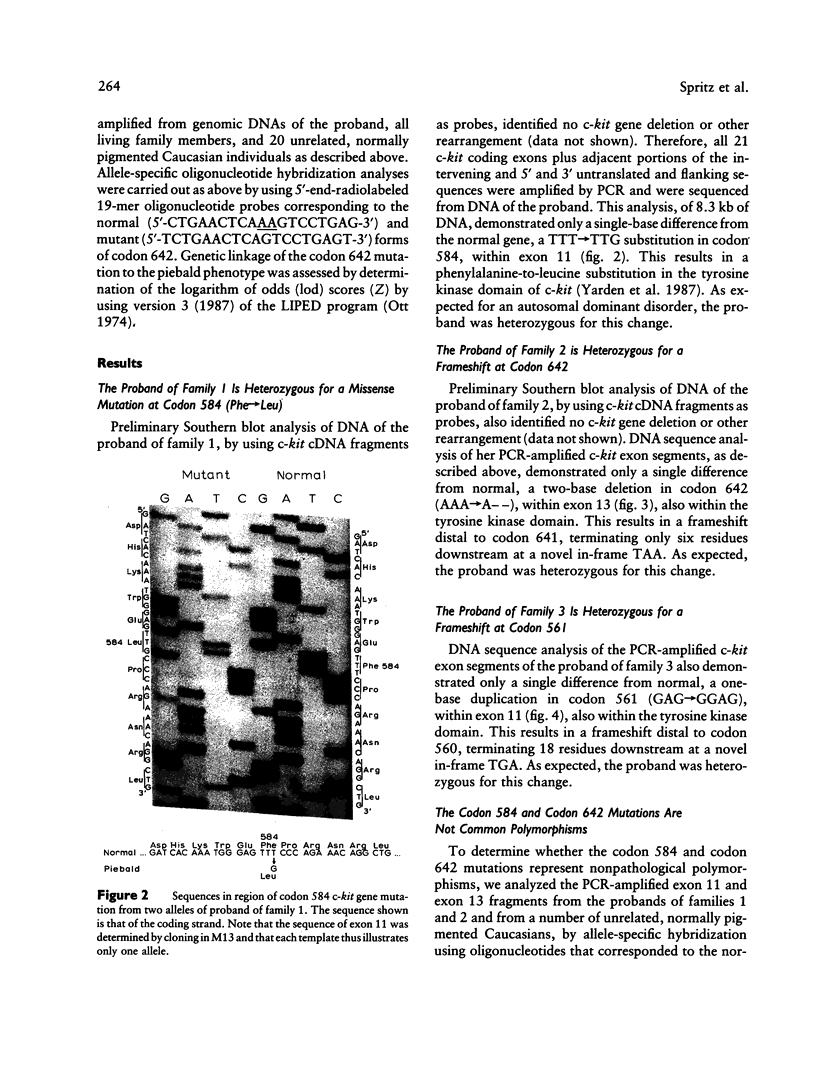

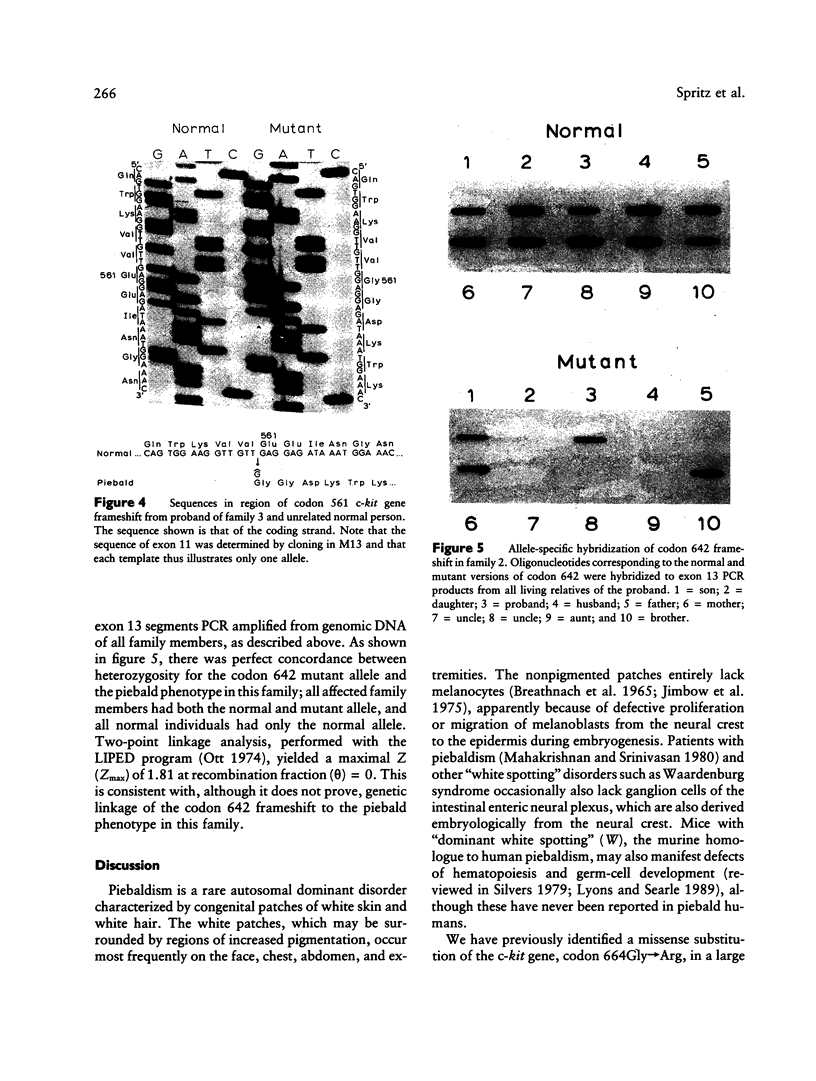
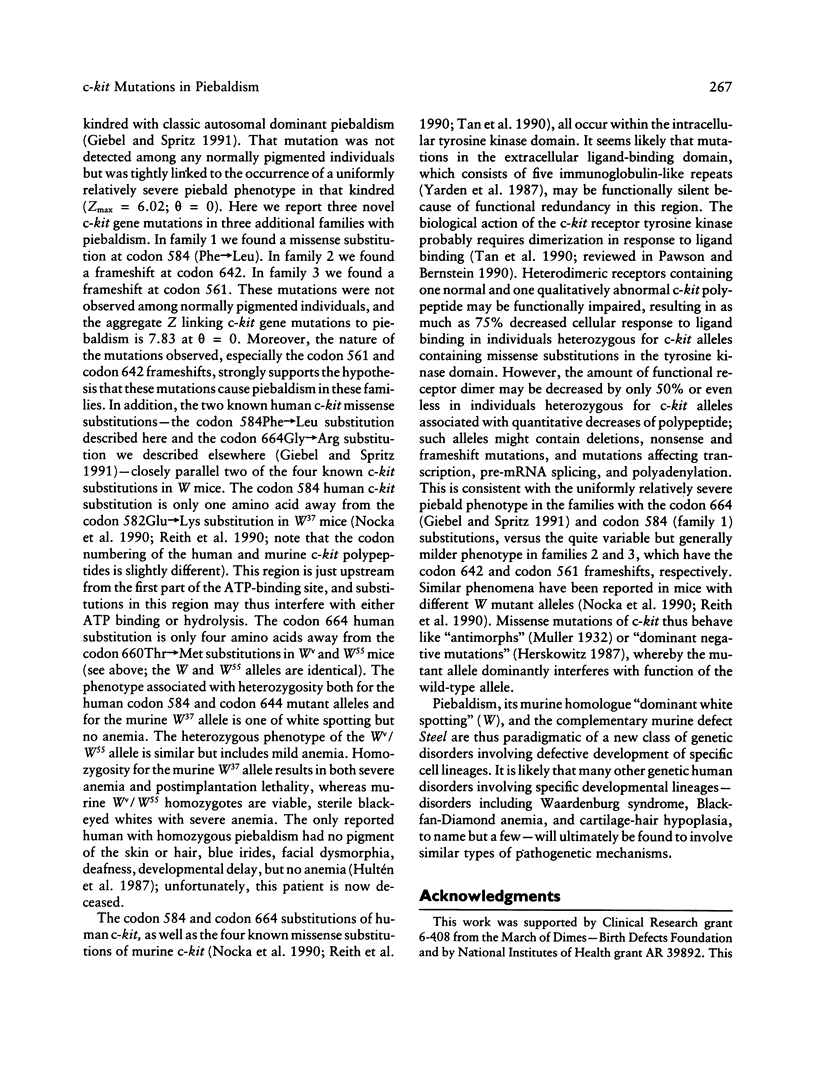
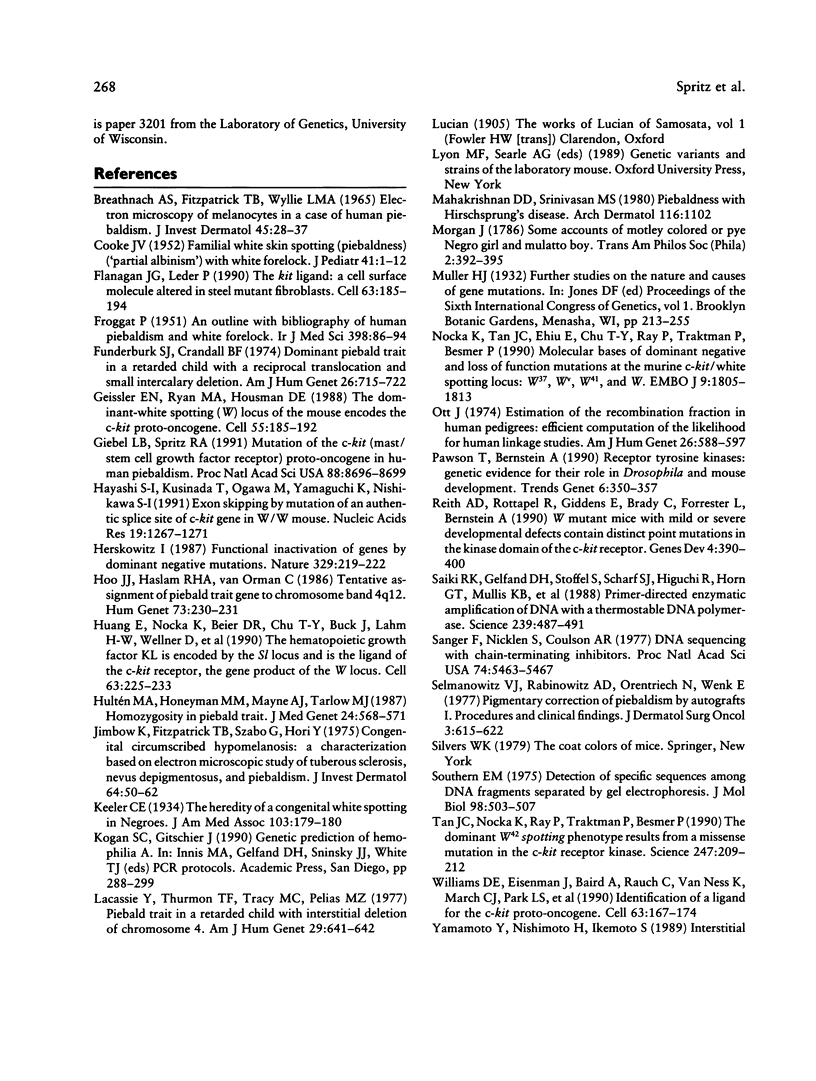
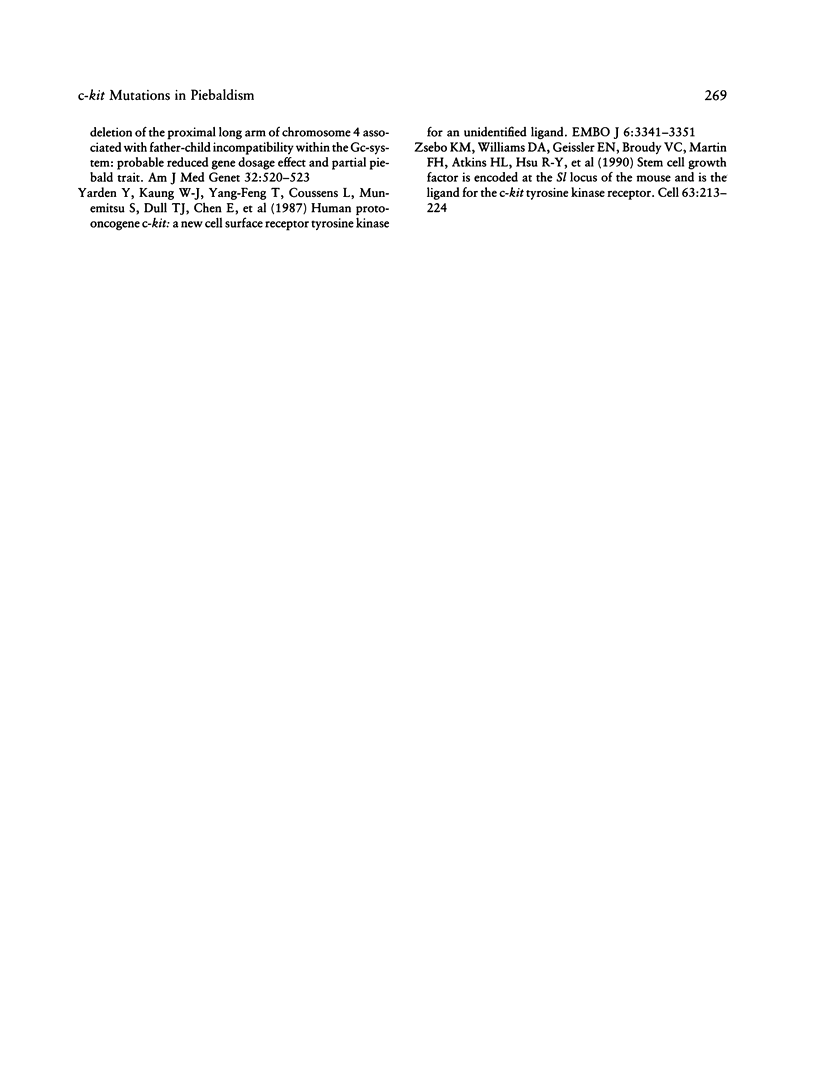
Images in this article
Selected References
These references are in PubMed. This may not be the complete list of references from this article.
- BREATHNACH A. S., FITZPATRICK T. B., WYLLIE L. M. ELECTRON MICROSCOPY OF MELANOCYTES IN HUMAN PIEBALDISM. J Invest Dermatol. 1965 Jul;45:28–37. doi: 10.1038/jid.1965.87. [DOI] [PubMed] [Google Scholar]
- COOKE J. V. Familial white skin spotting (piebaldness) ("partial albinism") with white forelock. J Pediatr. 1952 Jul;41(1):1–12. doi: 10.1016/s0022-3476(52)80022-8. [DOI] [PubMed] [Google Scholar]
- Flanagan J. G., Leder P. The kit ligand: a cell surface molecule altered in steel mutant fibroblasts. Cell. 1990 Oct 5;63(1):185–194. doi: 10.1016/0092-8674(90)90299-t. [DOI] [PubMed] [Google Scholar]
- Funderburk S. J., Crandall B. F. Dominant piebald trait in a retarded child with a reciprocal translocation and small intercalary deletion. Am J Hum Genet. 1974 Nov;26(6):715–722. [PMC free article] [PubMed] [Google Scholar]
- Geissler E. N., Ryan M. A., Housman D. E. The dominant-white spotting (W) locus of the mouse encodes the c-kit proto-oncogene. Cell. 1988 Oct 7;55(1):185–192. doi: 10.1016/0092-8674(88)90020-7. [DOI] [PubMed] [Google Scholar]
- Giebel L. B., Spritz R. A. Mutation of the KIT (mast/stem cell growth factor receptor) protooncogene in human piebaldism. Proc Natl Acad Sci U S A. 1991 Oct 1;88(19):8696–8699. doi: 10.1073/pnas.88.19.8696. [DOI] [PMC free article] [PubMed] [Google Scholar]
- Hayashi S., Kunisada T., Ogawa M., Yamaguchi K., Nishikawa S. Exon skipping by mutation of an authentic splice site of c-kit gene in W/W mouse. Nucleic Acids Res. 1991 Mar 25;19(6):1267–1271. doi: 10.1093/nar/19.6.1267. [DOI] [PMC free article] [PubMed] [Google Scholar]
- Herskowitz I. Functional inactivation of genes by dominant negative mutations. Nature. 1987 Sep 17;329(6136):219–222. doi: 10.1038/329219a0. [DOI] [PubMed] [Google Scholar]
- Hoo J. J., Haslam R. H., van Orman C. Tentative assignment of piebald trait gene to chromosome band 4q12. Hum Genet. 1986 Jul;73(3):230–231. doi: 10.1007/BF00401233. [DOI] [PubMed] [Google Scholar]
- Huang E., Nocka K., Beier D. R., Chu T. Y., Buck J., Lahm H. W., Wellner D., Leder P., Besmer P. The hematopoietic growth factor KL is encoded by the Sl locus and is the ligand of the c-kit receptor, the gene product of the W locus. Cell. 1990 Oct 5;63(1):225–233. doi: 10.1016/0092-8674(90)90303-v. [DOI] [PubMed] [Google Scholar]
- Hultén M. A., Honeyman M. M., Mayne A. J., Tarlow M. J. Homozygosity in piebald trait. J Med Genet. 1987 Sep;24(9):568–571. doi: 10.1136/jmg.24.9.568. [DOI] [PMC free article] [PubMed] [Google Scholar]
- Jimbow K., Fitzpatrick T. B., Szabo G., Hori Y. Congenital circumscribed hypomelanosis: a characterization based on electron microscopic study of tuberous sclerosis, nevus depigmentosus, and piebaldism. J Invest Dermatol. 1975 Jan;64(1):50–62. doi: 10.1111/1523-1747.ep12540914. [DOI] [PubMed] [Google Scholar]
- Lacassie Y., Thurmon T. F., Tracy M. C., Pelias M. Z. Piebald trait in a retarded child with interstitial deletion of chromosome 4. Am J Hum Genet. 1977 Nov;29(6):641–642. [PMC free article] [PubMed] [Google Scholar]
- Mahakrishnan A., Srinivasan M. S. Piebaldness with Hirschsprung's disease. Arch Dermatol. 1980 Oct;116(10):1102–1102. [PubMed] [Google Scholar]
- Nocka K., Tan J. C., Chiu E., Chu T. Y., Ray P., Traktman P., Besmer P. Molecular bases of dominant negative and loss of function mutations at the murine c-kit/white spotting locus: W37, Wv, W41 and W. EMBO J. 1990 Jun;9(6):1805–1813. doi: 10.1002/j.1460-2075.1990.tb08305.x. [DOI] [PMC free article] [PubMed] [Google Scholar]
- Ott J. Estimation of the recombination fraction in human pedigrees: efficient computation of the likelihood for human linkage studies. Am J Hum Genet. 1974 Sep;26(5):588–597. [PMC free article] [PubMed] [Google Scholar]
- Pawson T., Bernstein A. Receptor tyrosine kinases: genetic evidence for their role in Drosophila and mouse development. Trends Genet. 1990 Nov;6(11):350–356. doi: 10.1016/0168-9525(90)90276-c. [DOI] [PubMed] [Google Scholar]
- Reith A. D., Rottapel R., Giddens E., Brady C., Forrester L., Bernstein A. W mutant mice with mild or severe developmental defects contain distinct point mutations in the kinase domain of the c-kit receptor. Genes Dev. 1990 Mar;4(3):390–400. doi: 10.1101/gad.4.3.390. [DOI] [PubMed] [Google Scholar]
- Saiki R. K., Gelfand D. H., Stoffel S., Scharf S. J., Higuchi R., Horn G. T., Mullis K. B., Erlich H. A. Primer-directed enzymatic amplification of DNA with a thermostable DNA polymerase. Science. 1988 Jan 29;239(4839):487–491. doi: 10.1126/science.2448875. [DOI] [PubMed] [Google Scholar]
- Sanger F., Nicklen S., Coulson A. R. DNA sequencing with chain-terminating inhibitors. Proc Natl Acad Sci U S A. 1977 Dec;74(12):5463–5467. doi: 10.1073/pnas.74.12.5463. [DOI] [PMC free article] [PubMed] [Google Scholar]
- Selmanowitz V. J., Rabinowitz A. D., Orentreich N., Wenk E. Pigmentary correction of piebaldism by autografts. I. Procedures and clinical findings. J Dermatol Surg Oncol. 1977 Nov-Dec;3(6):615–622. doi: 10.1111/j.1524-4725.1977.tb00368.x. [DOI] [PubMed] [Google Scholar]
- Tan J. C., Nocka K., Ray P., Traktman P., Besmer P. The dominant W42 spotting phenotype results from a missense mutation in the c-kit receptor kinase. Science. 1990 Jan 12;247(4939):209–212. doi: 10.1126/science.1688471. [DOI] [PubMed] [Google Scholar]
- Williams D. E., Eisenman J., Baird A., Rauch C., Van Ness K., March C. J., Park L. S., Martin U., Mochizuki D. Y., Boswell H. S. Identification of a ligand for the c-kit proto-oncogene. Cell. 1990 Oct 5;63(1):167–174. doi: 10.1016/0092-8674(90)90297-r. [DOI] [PubMed] [Google Scholar]
- Yamamoto Y., Nishimoto H., Ikemoto S. Interstitial deletion of the proximal long arm of chromosome 4 associated with father-child incompatibility within the Gc-system: probable reduced gene dosage effect and partial piebald trait. Am J Med Genet. 1989 Apr;32(4):520–523. doi: 10.1002/ajmg.1320320419. [DOI] [PubMed] [Google Scholar]
- Yarden Y., Kuang W. J., Yang-Feng T., Coussens L., Munemitsu S., Dull T. J., Chen E., Schlessinger J., Francke U., Ullrich A. Human proto-oncogene c-kit: a new cell surface receptor tyrosine kinase for an unidentified ligand. EMBO J. 1987 Nov;6(11):3341–3351. doi: 10.1002/j.1460-2075.1987.tb02655.x. [DOI] [PMC free article] [PubMed] [Google Scholar]
- Zsebo K. M., Williams D. A., Geissler E. N., Broudy V. C., Martin F. H., Atkins H. L., Hsu R. Y., Birkett N. C., Okino K. H., Murdock D. C. Stem cell factor is encoded at the Sl locus of the mouse and is the ligand for the c-kit tyrosine kinase receptor. Cell. 1990 Oct 5;63(1):213–224. doi: 10.1016/0092-8674(90)90302-u. [DOI] [PubMed] [Google Scholar]



